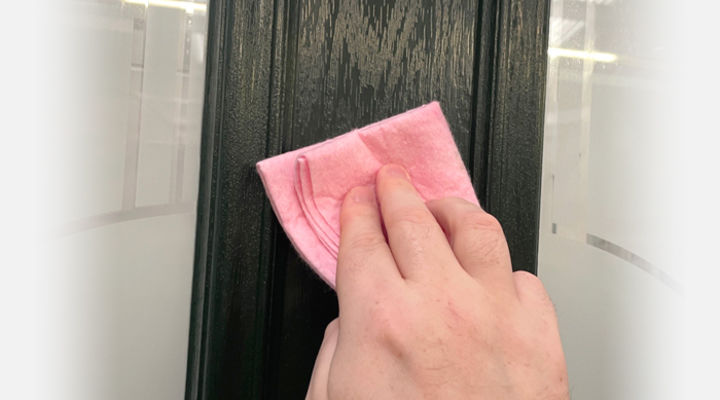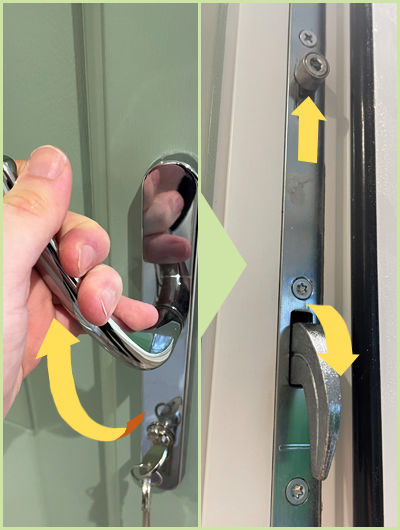Door Maintenance Guide

Your front door makes an impression, so you want it to look its best. You also want it to work as it should, without squeaky hinges or stiff handles. Unfortunately, some doors need more care than others. In this blog, you’ll learn about low-maintenance doors, and proper ways to keep them clean and keep them working effectively. So, if you’re fed up with the constant T.L.C. (tiringly long cleaning), read on.
What doors require the most maintenance?
- Traditional wooden doors generally need the most care of door types commonly on the market for UK homes. They are not as resistant to the elements as other materials, which can cause problems with insulation and security due to warping. Wood requires paint to colour, which can chip or peel in the sun and rain.
What is the best low maintenance door?
- A composite door requires the least maintenance. It not only resembles a traditional wooden door, but is designed with weather resistance in mind, so will not warp or absorb moisture. A GRP skin makes this door easy to clean, and what’s more – the colour is integrated, so you won’t need to repaint it. The composite’s sturdiness also makes it effective for security.
- UPVC doors are a lightweight and more budget-friendly option. They offer the same weather-resistant qualities as a composite, and also don’t need repainting – with options for woodgrain finishes too.
Is any door “maintenance-free”?
- No door is truly maintenance-free, and even low-maintenance doors require care from time to time. However, with the right care, your door will continue to look great and work well for years to come.
What is the best way to clean a composite or UPVC door?
- Warm soapy water and a clean cloth or sponge – These are your best friends for cleaning a door.
What NOT to do to clean your door!
- DO NOT use abrasives – These include hard brushes and scouring pads, as their harsh surfaces will leave scratches.
- DO NOT use washing-up liquid or solvents – Using such products can risk discolouring your door and leaving unsightly residue.
- DO NOT use a power washer – The high pressure can damage areas of the door, affecting its functionality.

How to clean a composite or UPVC door
- Remove jewellery before attempting to clean – Rings, bracelets and watches can accidentally scratch the surface if not removed.
- Wipe away loose dirt first – Get rid of loose dirt before attempting to wash your door, using a clean cloth to brush off any grit or other lying substances. This will prevent accidental scratches.
- Mix a little soap with warm water – Remember NOT to use solvents or washing-up liquid!
- Wipe the door from top to bottom – Dip a clean cloth or sponge into the soapy water and wipe down the door. Go from top to bottom so as not to leave streaks.
- Clean the hardware – Use the same soapy water and cloth to give your handles and accessories a sparkling clean!
- Give it a dry – Wipe the door with a clean cloth to dry it off.
- Don’t forget the other side – You’ll want to repeat the process for the other side of your door.
- Clean the glass – Polish it using a cloth and soapy water, then use a dry cloth to remove remaining moisture. Finish with a proprietary glass cleaner.
Do I need to paint a composite or UPVC door?
- You shouldn’t need to paint a composite or UPVC door, as it has a finish that is UV-stable (resistant to fading in sunlight) and weather-resistant (won’t run with moisture and won’t chip in the sun).
- If the surface of your door does get scratched or chipped, you can apply a touch-up pen or specialised paint to the affected area. For a touch-up pen – shake for a few seconds, press lightly onto a surface to test, then apply the pen onto the affected area.

How to maintain hardware
- Keep handles, hinges and other moving parts at their best by lubricating them with a little light engineering oil (such as 3-in-1®). This is especially important if you live in a coastal area or near a building/industrial site, as minerals can affect the performance of hardware.
- DO NOT use petroleum-based lubricants (such as WD-40®), as these can dry out and attract dirt, clogging moving parts in the process.

- If your door uses lever handles, check that the top and bottom locking points engage by turning one of the handles up. This will help to protect your door from natural thermal distortion.
- For microchip-activated catflaps/pet doors and smart handles, ensure that there is sufficient power to operate (that batteries/power supplies have enough life or charge). The manufacturers’ instructions will give the best guidance on how often you should replace batteries or rechange power supplies for specific devices.

How often should I maintain my door?
- You should clean your door once a month to ensure it stays in top condition.
- Maintain hardware every six months to keep your door functioning for years to come.
Time for a new door?
We offer a wide selection of low-maintenance composite and UPVC doors. To order yours:
- Call us free – Speak to our door experts on 0800 910 1122 to discuss your requirements.
- Message us – You can send a quick message via the blue tab on the right, or by visiting our Contact Us page.
- or view our styles online – See for yourself the range of style we offer for composite and UPVC doors, available Fully Fitted or Supply Only.
or

